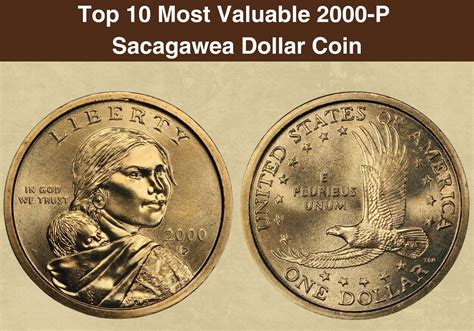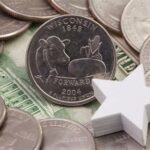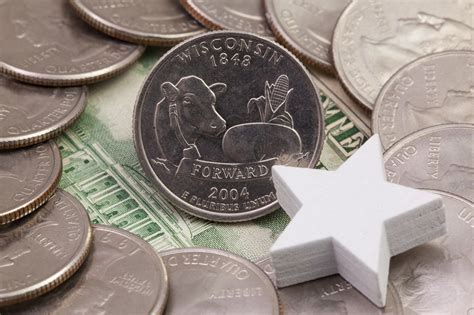
A rare 2004 Wisconsin state quarter, minted with a striking error involving an extra leaf on the corn stalk design, could be worth as much as $2,000, prompting coin collectors and casual spenders alike to meticulously examine their spare change. The “extra leaf” varieties, caused by die errors during the minting process, have become highly sought after by numismatists, turning everyday pocket change into potential windfalls.
The buzz surrounding these quarters highlights the fascinating world of coin collecting and the lucrative possibilities hidden within seemingly ordinary currency. According to experts, the value of these coins depends on their condition, rarity, and the specific type of error. The 2004 Wisconsin quarter error has two distinct varieties: the “extra leaf high” and the “extra leaf low,” both stemming from different die flaws at the U.S. Mint. The specific error occurred on the reverse side of the quarter, which features a corn stalk, a prominent symbol of Wisconsin’s agricultural heritage.
The hunt for these valuable quarters has intensified since the initial discovery of the error shortly after their release in 2004. The error quickly became widely publicized in numismatic circles, fueling demand and subsequently driving up prices. While not all 2004 Wisconsin quarters are worth a fortune, those with the discernible extra leaf fetch prices considerably higher than their face value.
To identify the valuable error coin, individuals should closely inspect the corn stalk on the reverse side of the 2004 Wisconsin quarter. The “extra leaf” appears as an additional leaf or protrusion extending from the corn stalk. Specifically, one version exhibits the extra leaf pointing upwards (“high”), while the other shows it pointing downwards (“low”). A magnifying glass can aid in spotting the minute detail, especially on coins that show signs of wear.
The value attributed to these quarters is not merely speculative. Reputable coin grading services, such as the Professional Coin Grading Service (PCGS) and the Numismatic Guaranty Corporation (NGC), authenticate and grade coins, providing a recognized standard for their condition and value. Coins graded in higher conditions, such as “Mint State” (MS) with grades like MS65 or higher, command the highest prices. Factors affecting the value include the strike quality, luster, and the absence of blemishes or wear. Coins that have been circulated and exhibit wear will typically be valued lower.
The U.S. Mint’s state quarter program, which ran from 1999 to 2008, celebrated each of the 50 states with unique designs on the reverse side of the quarter. This program not only popularized coin collecting but also inadvertently created opportunities for error coins to emerge, adding to the hobby’s appeal. The 2004 Wisconsin quarter, with its distinctive error, stands out as one of the most sought-after and valuable coins from the entire series.
“It’s always exciting when these stories resurface because it reminds people to check their change,” said a spokesperson for a major coin collecting organization. “You never know what you might find, and even if you don’t find a rare 2004 quarter, you might discover other valuable coins that could be worth more than their face value.”
The surge in interest in coin collecting, fueled by stories of valuable error coins and the accessibility of information through online resources, has created a vibrant community of collectors and investors. Online auction sites like eBay, dedicated coin collecting forums, and professional coin dealers provide platforms for buying, selling, and appraising coins. However, experts caution potential buyers and sellers to exercise due diligence and seek professional guidance to ensure fair transactions and accurate coin grading.
Beyond the financial aspect, coin collecting offers a unique window into history, art, and culture. Each coin tells a story, reflecting the era in which it was minted, the values it represented, and the historical figures it commemorated. The 2004 Wisconsin quarter, even without the error, provides a glimpse into the state’s agricultural heritage. With the error, it becomes a tangible reminder of the intricacies of the minting process and the element of chance that can transform an ordinary object into a valuable artifact.
The hunt for the 2004 Wisconsin “extra leaf” quarter underscores the enduring appeal of numismatics and the possibility of uncovering hidden treasures in the most unexpected places. While the odds of finding one of these valuable coins may be slim, the potential reward and the thrill of the search continue to captivate coin collectors and casual observers alike.
Detailed Examination of the 2004 Wisconsin Quarter Error
The 2004 Wisconsin quarter, part of the 50 State Quarters Program, was intended to honor the state’s heritage and economy. The standard design features a cow, a wheel of cheese, and an ear of corn, symbolizing Wisconsin’s dairy industry and agricultural prowess. The error, however, transforms this ordinary coin into a highly desirable collectible.
Origin of the Error: The “extra leaf” error occurred during the die-making process at the U.S. Mint. A die is a metal piece used to stamp the design onto blank coins (planchets). In this case, a mishap during the creation of the reverse die for the Wisconsin quarter resulted in an unintended raised area that appears as an additional leaf on the corn stalk. This error was not caught during quality control and made its way into circulation.
Two Variations: “High Leaf” and “Low Leaf”: There are two main variations of the “extra leaf” error: the “extra leaf high” and the “extra leaf low.”
-
“Extra Leaf High”: In this variation, the extra leaf appears as a raised protrusion pointing upwards from the left side of the corn stalk. It is located closer to the top of the corn stalk, hence the term “high.”
-
“Extra Leaf Low”: In the “extra leaf low” variety, the extra leaf also protrudes from the left side of the corn stalk, but it is situated lower down, closer to the base of the stalk.
The existence of two distinct variations suggests that the die error occurred on multiple dies, further contributing to the coin’s rarity and value.
Identifying the Error: Identifying the 2004 Wisconsin quarter with the “extra leaf” error requires careful visual inspection. Here’s a step-by-step guide:
- Locate the Reverse Side: The error is found on the reverse (tails) side of the coin, which features the Wisconsin design.
- Examine the Corn Stalk: Focus on the corn stalk located on the left side of the design.
- Look for an Extra Leaf: Search for a small, raised protrusion or leaf extending from the corn stalk. Remember to differentiate between the “high” and “low” variations based on the leaf’s position.
- Use Magnification: A magnifying glass or a jeweler’s loupe can be extremely helpful, especially for coins that are worn or have minor imperfections.
- Compare with Images: Online resources and coin collecting websites provide clear images of the error coin, allowing you to compare your coin with known examples.
Factors Influencing Value: Several factors determine the value of a 2004 Wisconsin quarter with the “extra leaf” error:
-
Condition (Grade): The coin’s condition is the most significant factor influencing its value. Coins in pristine, uncirculated condition (Mint State) are worth considerably more than those that have been circulated and show wear. Coin grading services like PCGS and NGC assign grades based on factors like luster, strike quality, and the presence of scratches or blemishes.
-
Rarity: While the “extra leaf” error is relatively rare compared to regular 2004 Wisconsin quarters, the exact number of error coins in circulation is unknown. This scarcity contributes to the coin’s value.
-
Variation (High vs. Low): There may be slight differences in value between the “extra leaf high” and “extra leaf low” variations, depending on their relative scarcity and collector demand. However, both are generally considered valuable.
-
Certification: Having a coin authenticated and graded by a reputable grading service like PCGS or NGC can significantly increase its value. Certification provides assurance of the coin’s authenticity and condition, making it more desirable to collectors.
Valuation and Market Trends: The value of 2004 Wisconsin quarters with the “extra leaf” error can vary widely depending on the factors mentioned above.
-
Circulated Coins: Circulated examples of the “extra leaf” quarter, showing signs of wear, might fetch prices ranging from $100 to $500, depending on the degree of wear and the specific variation.
-
Uncirculated Coins: Uncirculated coins in higher grades (e.g., MS65 or higher) can command prices ranging from $1,000 to $2,000 or even higher, especially if they are certified by PCGS or NGC.
-
Auction Prices: Auction prices can fluctuate based on market demand and the specific characteristics of the coin. It’s advisable to monitor recent auction results to get a sense of current market values.
The 50 State Quarters Program: A Numismatic Phenomenon: The 50 State Quarters Program, which ran from 1999 to 2008, was a major success for the U.S. Mint. The program aimed to celebrate each of the 50 states by featuring unique designs on the reverse side of the quarter.
-
Increased Interest in Coin Collecting: The program significantly boosted interest in coin collecting, attracting both seasoned numismatists and casual collectors.
-
Educational Value: The state quarters provided a fun and engaging way for people to learn about the history, geography, and culture of the United States.
-
Economic Impact: The program generated substantial revenue for the U.S. Mint through the sale of quarter sets and related numismatic products.
-
Legacy of Error Coins: The 50 State Quarters Program also led to the discovery of several error coins, including the 2004 Wisconsin quarter with the “extra leaf” error. These error coins have become highly sought after by collectors, adding to the program’s legacy.
Where to Buy and Sell Error Coins:
-
Coin Dealers: Local coin shops and reputable coin dealers are good places to buy, sell, or appraise error coins. Dealers can provide expert advice and guidance.
-
Online Auction Sites: Online auction sites like eBay are popular platforms for buying and selling coins. However, it’s crucial to exercise caution and research the seller’s reputation before making a purchase.
-
Coin Shows: Coin shows and conventions are excellent opportunities to meet with dealers, collectors, and grading service representatives.
-
Coin Collecting Forums: Online coin collecting forums provide a platform for sharing information, asking questions, and connecting with other collectors.
Protecting Your Coins: If you believe you have found a valuable 2004 Wisconsin quarter with the “extra leaf” error, it’s essential to protect it properly.
-
Handle with Care: Always handle coins by the edges to avoid scratching or damaging the surface.
-
Store Properly: Store coins in acid-free holders or albums designed for coin storage.
-
Avoid Cleaning: Never clean coins, as this can damage their surface and reduce their value.
The Enduring Appeal of Numismatics: Coin collecting, or numismatics, is a hobby that has captivated people for centuries. It offers a unique blend of history, art, and economics.
-
Historical Significance: Coins provide a tangible link to the past, reflecting the history, culture, and values of the societies that produced them.
-
Artistic Merit: Coins can be works of art, showcasing intricate designs and skilled craftsmanship.
-
Investment Potential: Rare and valuable coins can be a sound investment, appreciating in value over time.
The psychology of the hunt
The chase for rare coins like the 2004 Wisconsin quarter taps into several psychological factors that make coin collecting so appealing.
-
The thrill of discovery: The act of sifting through pocket change or examining rolls of coins creates a sense of anticipation and excitement. The possibility of finding a valuable error coin provides a reward and a sense of accomplishment.
-
Pattern Recognition: Identifying a specific error requires attention to detail and pattern recognition skills. This can be mentally stimulating and provide a sense of satisfaction.
-
Nostalgia and Connection to the Past: Coins are tangible objects that connect us to history. They can evoke feelings of nostalgia and curiosity about the past.
-
Community and Social Interaction: Coin collecting is often a social activity. Collectors share knowledge, trade coins, and participate in local or online communities.
The Role of Media and Information Dissemination: The internet and social media play a significant role in disseminating information about rare coins and error varieties. Online articles, videos, and forums can quickly spread awareness about a valuable coin, creating a surge in demand and driving up prices. This rapid dissemination of information can also lead to increased competition among collectors and make it more challenging to find rare coins.
The Future of Coin Collecting: Coin collecting continues to evolve in the digital age. Online resources, virtual coin shows, and digital catalogs have made it easier than ever to learn about and collect coins. However, the fundamentals of numismatics—historical knowledge, appreciation of art, and the thrill of discovery—remain as relevant as ever. The enduring appeal of coin collecting ensures that it will continue to be a popular and rewarding hobby for generations to come.
The Risks of Counterfeiting:
As the value of error coins like the 2004 Wisconsin quarter increases, so does the risk of counterfeiting. Unscrupulous individuals may attempt to create fake error coins or alter genuine coins to resemble more valuable varieties. It is crucial to be aware of this risk and take precautions when buying or selling error coins.
- Buy from Reputable Sources: Always purchase coins from trusted dealers or reputable online sellers.
- Examine Carefully: Carefully inspect the coin for any signs of alteration or tampering.
- Seek Professional Authentication: If you are unsure about the authenticity of a coin, have it authenticated by a reputable grading service like PCGS or NGC.
The U.S. Mint’s Response to Errors:
The U.S. Mint generally does not comment on specific coin errors or their value. However, the Mint does have quality control procedures in place to minimize the occurrence of errors during the minting process. When errors do occur, the Mint typically does not recall the coins, as the cost of recalling and replacing them would outweigh the value of the errors. Instead, error coins are left to circulate, becoming sought-after collectibles.
A Closer Look at the Minting Process:
Understanding the coin minting process can shed light on how errors like the “extra leaf” can occur. The process involves several stages:
-
Die Creation: Dies are created from a master hub, which contains the design for the coin. The master hub is used to create working hubs, which are then used to create working dies. Any flaw or imperfection on the master hub or working hub can be transferred to the working dies, resulting in an error on the coins.
-
Planchet Preparation: Planchets are blank metal discs that will be struck to become coins. The planchets are cleaned, annealed (heated to soften the metal), and upset (rimmed) before being fed into the striking press.
-
Striking: The planchets are fed into a striking press, where they are struck between two dies. The force of the strike imprints the design onto the planchet, creating the coin.
-
Quality Control: After striking, the coins are inspected for quality. Coins with obvious defects are rejected. However, minor errors may escape detection and make their way into circulation.
The “Spitting Horse” Error:
Besides the “extra leaf” error on the 2004 Wisconsin quarter, another notable error exists in the state quarter series. The 1999 Delaware quarter has an anomaly nicknamed the “Spitting Horse.” The error appears as if the horse is spitting, which is due to a die crack on the coin.
The Double Die Error
A “double die” error happens when the die used to strike the coins has a doubled image. This occurs when the die is not properly aligned during the hubbing process, creating a noticeable doubling of the design elements on the coin. These types of errors can significantly increase the value of a coin, depending on the prominence of the doubling and the rarity of the coin.
The Importance of Research and Due Diligence:
Whether you’re a seasoned collector or a beginner, research and due diligence are essential when buying or selling coins.
-
Consult Reputable Sources: Rely on reputable coin collecting guides, websites, and forums for information.
-
Seek Expert Advice: Consult with experienced coin dealers or graders for guidance and advice.
-
Compare Prices: Compare prices from multiple sources before making a purchase or sale.
-
Be Cautious of Scams: Be wary of deals that seem too good to be true, as they may be scams.
The Emotional Value of Collecting:
While the financial aspect of coin collecting is appealing, the emotional value is often more significant. Coin collecting can provide a sense of accomplishment, a connection to history, and a shared passion with other collectors. The joy of discovering a rare coin or completing a set can be immensely rewarding, regardless of the coin’s monetary value.
FAQ About the 2004 Wisconsin Quarter Error:
-
What is the 2004 Wisconsin quarter error that makes it valuable?
- The valuable error is an “extra leaf” on the corn stalk design on the reverse (tails) side of the quarter. There are two variations: “extra leaf high” and “extra leaf low.”
-
How can I identify the “extra leaf” error on a 2004 Wisconsin quarter?
- Look at the corn stalk on the reverse side of the coin. The “extra leaf” appears as a small, raised protrusion or leaf extending from the corn stalk. Use a magnifying glass for a closer look.
-
How much is a 2004 Wisconsin quarter with the “extra leaf” error worth?
- The value depends on the coin’s condition. Circulated coins might be worth $100-$500, while uncirculated coins in high grades can fetch $1,000-$2,000 or more.
-
Where can I buy or sell 2004 Wisconsin quarters with the “extra leaf” error?
- You can buy or sell through coin dealers, online auction sites like eBay, coin shows, and coin collecting forums. Be sure to verify the reputation of the dealers and sellers.
-
Should I get my 2004 Wisconsin quarter graded if I think it has the “extra leaf” error?
- Yes, having the coin authenticated and graded by a reputable grading service like PCGS or NGC can significantly increase its value and provide assurance of its authenticity and condition.









